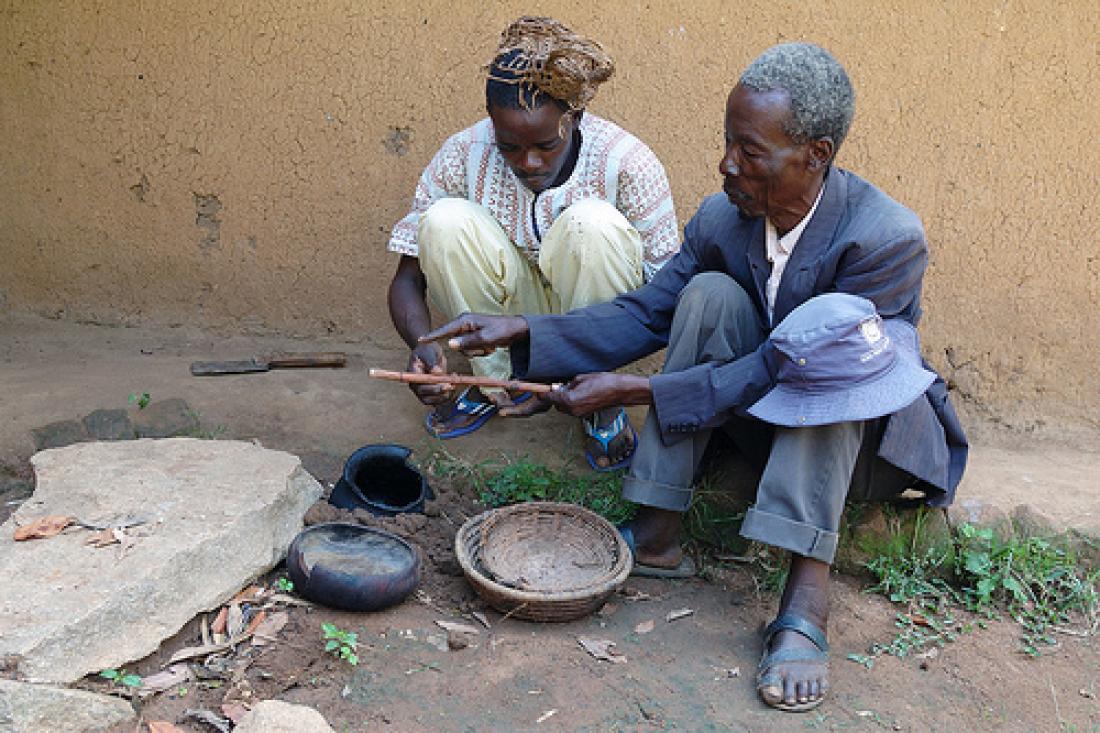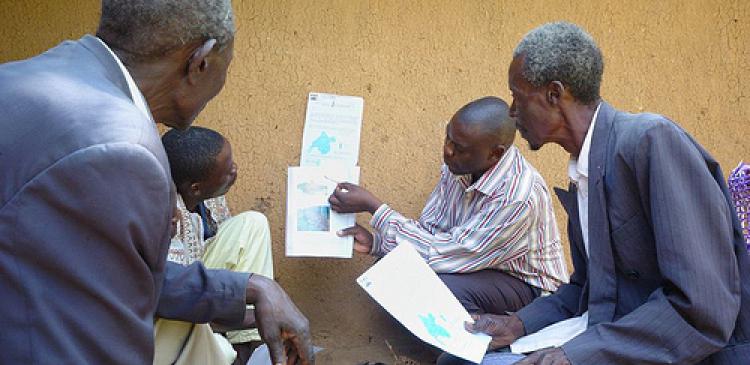Obedi Osore Nganyi instructs an apprentice on the rainmaker practice of pot blowing.
However, the erratic weather caused by climate change has made the signs rainmakers need for their forecast opaque. The Nganyi rainmakers have begun collaborating with meteorologists, combining their indigenous knowledge with modern science, to help them make more accurate weather forecast for the communities that depend on their advice.
“The rainmakers’ predictions are based on close observation of natural phenomena, like the budding or flowering of specific plant species and the behaviour of local insects and animals, associated with seasonal changes,” Mary O’Neill of Climate Change Adaptation in Africa (CCAA) told MediaGlobal. “As weather patterns have become erratic in their community in recent years, the Nganyi have been finding that these ‘indicator’ species are less and less reliable.”
“Climate change has come so fast,” said Obedi Osore, a traditional forecaster filmed in the CCAA’s video Nganyi Indigenous Knowledge Adaptation Project. “People don’t know how to adapt. Our traditional crops are disappearing because they can’t handle the new conditions.” Osore explained, “We need new strategies to handle the climate change issue.”
The Kenya Meteorology Department is adding its scientific knowledge to the traditional knowledge of the Nganyi, in a project lead by the IGAD Climate Prediction and Applications Centre (ICPAC) to provide more reliable information for communities at risk from climate change. The CCAA is supporting the project and sees this as a “valuable opportunity to explore how climate information can be made more accessible and relevant to rural people whose livelihoods depend on it,” said O’Neill. “People in many parts of rural Africa look to indigenous knowledge forecasters to tell them what the rains will bring, and how to prepare.”
Rainmakers’ predictions only pertain to the immediate community and the meteorologists forecast apply on the national and regional level. ICPAC believes the two groups will compliment each other to better serve parts of Kenya that have been affected by drought and erratic rainfall in recent years. The project uses a system that combines each group’s knowledge.
After making their predictions for the upcoming season, Nganyi rainmakers meet with researchers that compare the Nganyi forecast with a scientific forecast from the Climate Outlook Forum to develop a consensus forecast. The Nganyi shares the consensus forecast for the coming season with the local community, in local languages, through radio, in churches and other community gathering points. “The Nganyi provide their forecasts in simple and specific terms that are very relevant to local people,” explained O’Neill.
The project has been in use for two seasons with positive results. “The forecasts were surprisingly accurate for the local area, even on one occasion when it appeared to contradict the overall seasonal outlook at the country level,” said O’Neill.
The ICPAC is also documenting the Nganyi approach to forecasting. “The improved understanding of indigenous forecasting knowledge is being integrated into university curriculum on disaster risk management [that is] being developed at the Great Lakes University of Kisumu,” said O’Neill. It is important to ICPAC that there is a better understanding of indigenous systems of climate forecasting.
The information from the project is being used to protect the health and livelihood of the indigenous people from the impact of climate change. Relaying the information through traditional rainmakers will make it more accessible for local communities that find the scientific approach cluttered with technical terms. “The Nganyi rainmakers are particularly well known for their skills,” said O’Neill.
By incorporating the indigenous knowledge of the Nganyi with scientific weather technology, the ICPAC project has discovered a way to combat the affects of climate change without neglecting the heritage of the Nganyi people. People will continue to approach Nganyi forecaster Abineri Osango — a rainmaker interviewed in the CCAA’s video — and ask about the weather because “they have that confidence in us,” he said.




